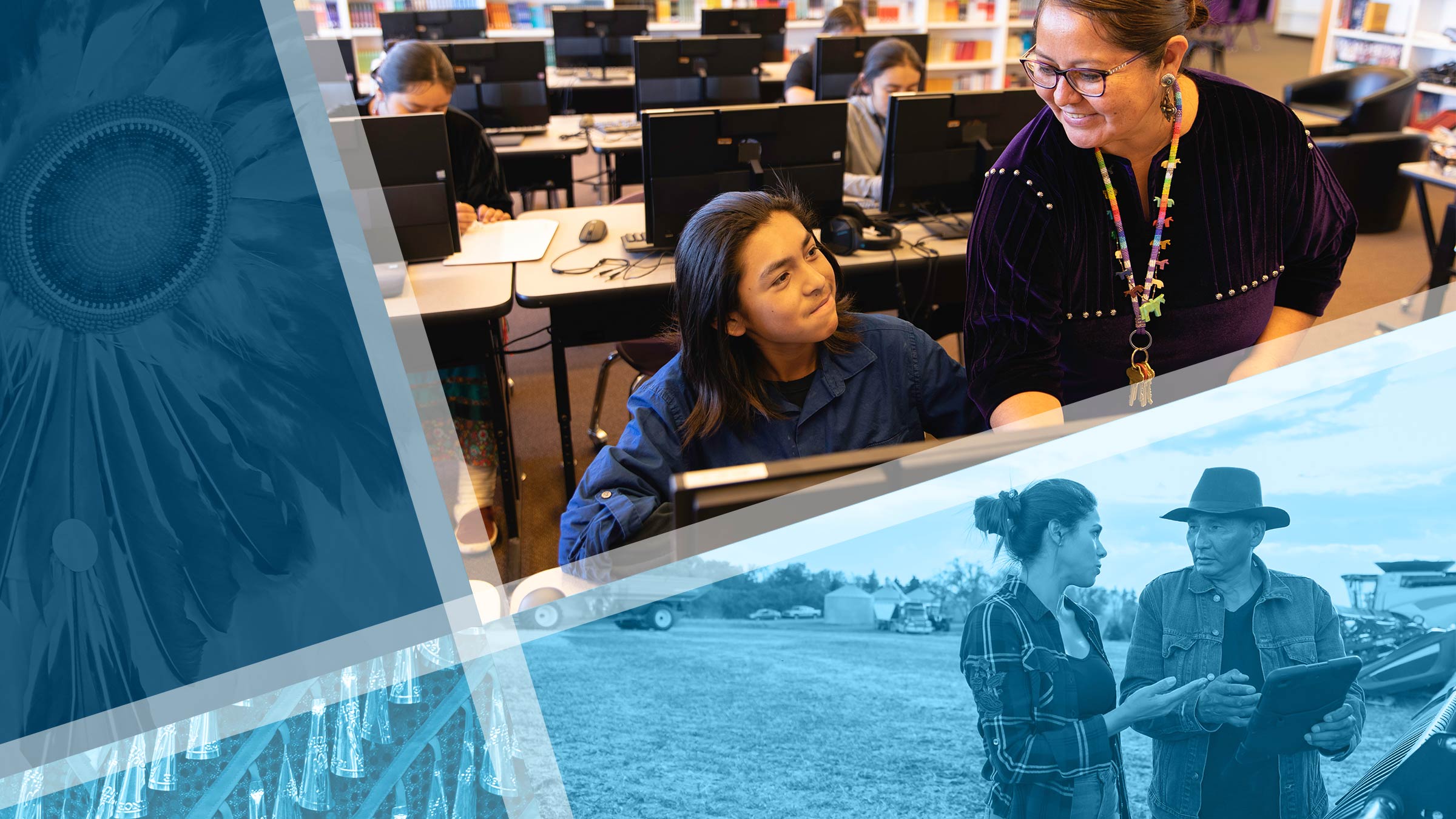Nuts, Bolts, and Cables: Opportunities in Tribal Broadband | Federal Reserve Bank of Minneapolis
Nuts, Bolts, and Cables: Opportunities in Tribal Broadband Federal Reserve Bank of Minneapolis


Geoffrey Blackwell: A Leader in Tribal Economic Development and Communications Infrastructure

Geoffrey Blackwell is a recognized expert in tribal economic and corporate development as well as communications infrastructure deployment. He serves as co-chair of the National Congress of American Indians’ (NCAI’s) Economic, Finance, and Community Development Committee and NCAI’s Technology and Telecommunications Subcommittee. His work with American Indian tribes, Alaska Native Villages, and Native Hawaiians has taken him to some of the most remote regions in the United States and to other Indigenous communities worldwide.
Achievements and Advocacy
- Recipient of Public Knowledge’s IP3 Internet Protocol Award for broadband policy advocacy on behalf of tribal nations in 2020.
- Testified before the U.S. Congress on seven occasions and before the U.S. Commission on Civil Rights as a tribal representative and senior federal regulator and policymaker.
Engagement with National Organizations
- Serves on the board of the Native American Rights Fund.
- Vice president of the advisory board for the American Indian Policy Institute at Arizona State University.
- Previously served on the boards of the National Small Business Association, National Federation of Community Broadcasters, Native Public Media, Acoma Pueblo Business Enterprises, and Indigenous Commission for Communications Technologies in the Americas.
Past Roles and Contributions
- First chief strategy officer and general counsel for AMERIND Risk Management Corporation, where he managed various teams including Legal, Finance, Information Technology, Human Resources, Corporate Communications, and Critical Infrastructure Broadband.
- Founding chief of the Federal Communications Commission’s (FCC’s) Office of Native Affairs and Policy in 2010, responsible for developing regulatory agendas to bring modern communications technologies to tribal communities nationwide.
- Served as a senior attorney and the FCC’s first formal liaison to tribal governments, working on important FCC tribal programs and policies such as Universal Service Fund programs, spectrum licensing, tower siting, and radio and TV broadcast licensing.
- Corporate director at Chickasaw Nation Industries, Inc., involved in structuring, developing, and guiding diverse LLCs and federal contracting companies.
- Started legal career in the corporate litigation department of Hale and Dorr, LLP, in Boston.
Background and Education
Geoffrey Blackwell comes from a family of tribal leaders and federal officials dedicated to service in Indian Country. He was raised in Oklahoma and New Mexico and spent significant time as a young adult in Washington, D.C. He is a graduate of Dartmouth College and the University of Virginia School of Law. Blackwell is Muscogee (Creek), Chickasaw, Choctaw, and Omaha.
SDGs, Targets, and Indicators Analysis
1. Which SDGs are addressed or connected to the issues highlighted in the article?
- SDG 9: Industry, Innovation, and Infrastructure
- SDG 10: Reduced Inequalities
- SDG 17: Partnerships for the Goals
The article discusses the work of Geoffrey Blackwell in tribal economic and corporate development, as well as communications infrastructure deployment. These issues are connected to SDG 9, which focuses on promoting sustainable industrialization, fostering innovation, and building resilient infrastructure. The article also mentions Blackwell’s advocacy on behalf of tribal nations, which relates to SDG 10, aiming to reduce inequalities within and among countries. Additionally, Blackwell’s involvement with national organizations and boards highlights the importance of partnerships for achieving the SDGs, specifically SDG 17.
2. What specific targets under those SDGs can be identified based on the article’s content?
- SDG 9.3: Increase access to ICT and provide universal and affordable access to the internet in least developed countries
- SDG 10.2: Empower and promote the social, economic, and political inclusion of all, irrespective of age, sex, disability, race, ethnicity, origin, religion, or economic or other status
- SDG 17.16: Enhance the global partnership for sustainable development, complemented by multi-stakeholder partnerships that mobilize and share knowledge, expertise, technology, and financial resources
Based on the article’s content, the specific targets that can be identified are related to increasing access to ICT and providing universal and affordable access to the internet in tribal communities (SDG 9.3). The article also highlights the importance of empowering and promoting the social, economic, and political inclusion of tribal nations and Native communities (SDG 10.2). Furthermore, the involvement of Blackwell in national organizations and boards demonstrates the need for enhancing global partnerships for sustainable development (SDG 17.16).
3. Are there any indicators mentioned or implied in the article that can be used to measure progress towards the identified targets?
- Indicator 9.c.1: Proportion of population covered by a mobile network, by technology
- Indicator 10.2.1: Proportion of people living below 50 percent of median income, by age, sex, and persons with disabilities
- Indicator 17.16.1: Number of countries reporting progress in multi-stakeholder development effectiveness monitoring frameworks that support the achievement of the sustainable development goals
The article does not explicitly mention indicators, but based on the identified targets, the following indicators can be used to measure progress:
– Indicator 9.c.1 can be used to measure the proportion of the tribal population covered by a mobile network and assess their access to ICT.
– Indicator 10.2.1 can be used to measure the proportion of tribal nations and Native communities living below 50 percent of median income, indicating their economic inclusion.
– Indicator 17.16.1 can be used to measure the number of countries reporting progress in multi-stakeholder development effectiveness monitoring frameworks related to tribal economic and corporate development.
4. SDGs, Targets, and Indicators Table
| SDGs | Targets | Indicators |
|---|---|---|
| SDG 9: Industry, Innovation, and Infrastructure | Increase access to ICT and provide universal and affordable access to the internet in least developed countries (Target 9.3) | Proportion of population covered by a mobile network, by technology (Indicator 9.c.1) |
| SDG 10: Reduced Inequalities | Empower and promote the social, economic, and political inclusion of all, irrespective of age, sex, disability, race, ethnicity, origin, religion, or economic or other status (Target 10.2) | Proportion of people living below 50 percent of median income, by age, sex, and persons with disabilities (Indicator 10.2.1) |
| SDG 17: Partnerships for the Goals | Enhance the global partnership for sustainable development, complemented by multi-stakeholder partnerships that mobilize and share knowledge, expertise, technology, and financial resources (Target 17.16) | Number of countries reporting progress in multi-stakeholder development effectiveness monitoring frameworks that support the achievement of the sustainable development goals (Indicator 17.16.1) |
Behold! This splendid article springs forth from the wellspring of knowledge, shaped by a wondrous proprietary AI technology that delved into a vast ocean of data, illuminating the path towards the Sustainable Development Goals. Remember that all rights are reserved by SDG Investors LLC, empowering us to champion progress together.
Source: minneapolisfed.org

Join us, as fellow seekers of change, on a transformative journey at https://sdgtalks.ai/welcome, where you can become a member and actively contribute to shaping a brighter future.







